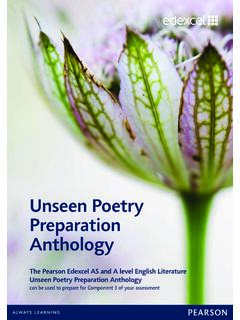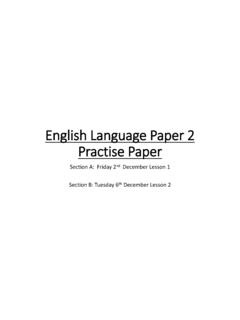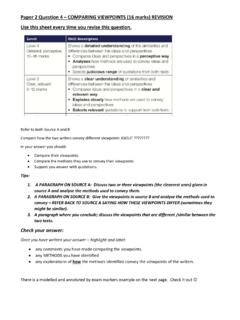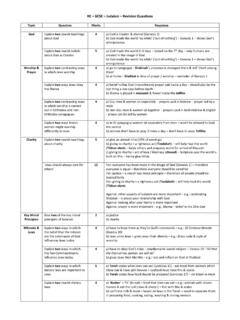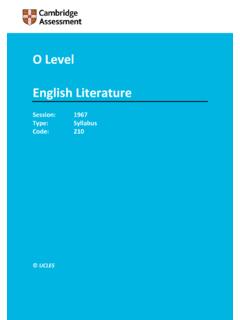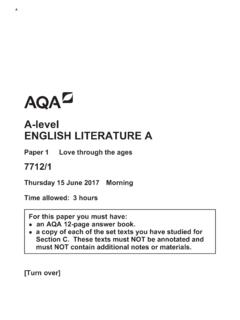Transcription of AS and A Level English Literature - Holy Trinity Academy
1 AS and A Level English Literature EXEMPLAR RESPONSES A Level paper 1 (Drama) Section A - Shakespeare 1 Contents About this exemplar pack ..2 Mark schemes for A Level paper 1, Section A ..3 EXEMPLAR SCRIPT A ..5 Hamlet ..5 Marker s Comments: ..6 EXEMPLAR SCRIPT B ..7 King Lear ..7 Marker s Comments: ..8 EXEMPLAR SCRIPT C ..9 Measure for Measure ..9 Marker s Comments: .. 10 EXEMPLAR SCRIPT 11 Othello .. 11 Marker s Comments: .. 12 EXEMPLAR SCRIPT E .. 13 The Taming of the Shrew .. 13 Marker s Comments: .. 14 EXEMPLAR SCRIPT F .. 15 Twelfth Night .. 15 Marker s Comments: .. 16 1 About this exemplar pack This pack has been produced to support English Literature teachers delivering the new GCE English Literature specification (first assessment summer 2017).
2 The pack contains exemplar student responses to GCE A Level English Literature paper 1 (Section A Shakespeare). It shows real student responses to the questions taken from the sample assessment materials. For schools delivering a co-taught AS and A Level course, the Shakespeare text will be covered in the second year, after the AS exams have been completed. For schools teaching a linear 2 year A Level only, the course content can be taught in any order. Please see the example course planners for more support on delivering the course content. The Shakespeare questions address 4 Assessment Objects: AO1, AO2, AO3 and AO5 Following each question you will find the mark scheme for the band that the student has achieved, with accompanying examiner comments on how the marks have been awarded, and any ways in which the response might have been improved.
3 In most cases, the students have addressed the AO5 requirement by reference to the Shakespeare Critical Anthology, in either comedy or tragedy as appropriate, although some have made reference to critical reading from other sources. There is no requirement to go beyond the anthologies, but you are, of course, welcome to do so. 2 Mark schemes for A Level paper 1, Section A 3 4 EXEMPLAR SCRIPT A Hamlet Question 2(a) Explore Shakespeare s use of revenge in Hamlet. You must relate your discussion to relevant contextual factors and ideas from your critical reading.
4 Hamlet is seen as an archetypal tragedy, involving falls from grace and changes from high to low status. However, more than this, Hamlet is a revenge play. Revenge Tragedies had been typically violent and gory but Shakespeare makes Hamlet much more than this, with the Mousetrap scene, the evocation of the ghost and the constant delaying of the revenge, i t seems that revenge is a theme Shakespeare wants to explore in this play in some depth. Hamlet has several failed attempts at revenge, and these come about because of his indecision. The first comes when Claudius is praying in the chapel and Hamlet comes up behind him, but decides not to stab him as, having just repented, his Uncle would go to heaven.
5 Hamlet wishes him instead to suffer in purgatory as his father does: And that his soul may be as damn d and black . This is an example of the role of religion within the play. Religion was a very key issue in Shakespeare s England and an important difference between Catholicism and Protestantism is that Catholics believe in Purgatory and Protestants do not. This theme echoes throughout Hamlet. The man most cynical of the ghost s existence is Horatio. The fact that Horatio studies at Wittenberg labels him as a protestant, as Wittenberg was the town in which Martin Luther effectively founded Protestantism.
6 Once Hamlet has made up his mind once and for all to kill Claudius, he is summoned by his mother and, whilst in her room, slays Polonius whom he believes to be Claudius: How now! A rat? Dead, for a ducat, dead! . This killing, albeit of the wrong man, shows the audience that Hamlet is now ready to exact his revenge fully. If the role of revenger is inevitable for this character, then we must question why Hamlet takes so long to exact his revenge and why he is so hesitant about it. Hazlitt describes him as, the prince of philosophical speculators. It is Hamlet s own conscience which holds him back.
7 He is hesitant to kill his uncle as this would be a sin. He knows that the action would not bring his father back. Indeed the ghost seems to recognise this conscience within the young Prince and asks him to put it aside in order to perform the task: If thou hast nature in thee bear it not. Many critics, for example Catherine Belsey, condemn revenge as extremist. Yet Hamlet s indecision is widely recognised as his Hamartia. Therefore, the failure to take revenge becomes the tragedy within the play. Following the path of narrative imperative as Bell has said - it will lead to Hamlet s downfall or death.
8 Hence revenge in Hamlet can never be thought of as diabolical or similar. At worst, it should be seen as the better of two evils. Had Hamlet killed his Uncle early on, say in the Chapel, and so am I revenged , then many more, including Hamlet would still have been alive. Instead, Hamlet s tragic flaw creates a chain reaction that brings the deaths of Polonius, Laertes, Ophelia, Claudius, Hamlet, Gertrude, Rosencrantz and Guildenstern instead of just the King. To demonstrate another side of revenge, Shakespeare shows us an unsuccessful but resolute avenger to watch. Laertes seeks to exact revenge for Polonius on Hamlet.
9 Even though he does kill Hamlet, Laertes is still an unsuccessful avenger for two reasons. First, because he ends up apologising to and forgiving Hamlet: Exchange forgiveness with me, Noble Hamlet . In using this language, Shakespeare speaks of how forgiveness must be mutual if it is to exist. Second, because he dies in the process of carrying out this revenge. Although his story follows 5the traditional lines of revenge, Laertes fails to bring about justice upon his nemesis at the final, and is therefore an unsuccessful revenger in the context of revenge tragedy. When Hamlet is finally successful in his revenge, it is a somewhat limited success, with the death of his mother going contrary to his ethereal father s wishes Against thy mother aught: leave her to heaven.
10 The reference to heaven suggests that Gertrude is an innocent party in the whole affair, which heightens the pathos of her death. It is muted also by the fact that he dies himself: Now cracks a noble heart In order to explore revenge fully, Shakespeare includes a successful revenger - Fortinbras of Norway. He seeks to avenge the wrongs done to his father, and take back the lands that Norway lost. In this, young Fortinbras is completely successful and he gains the throne of Denmark via Hamlet s instruction: But I do prophesy the election lights On Fortinbras: he has my dying Yet this, of all the revenges, is the least just.


